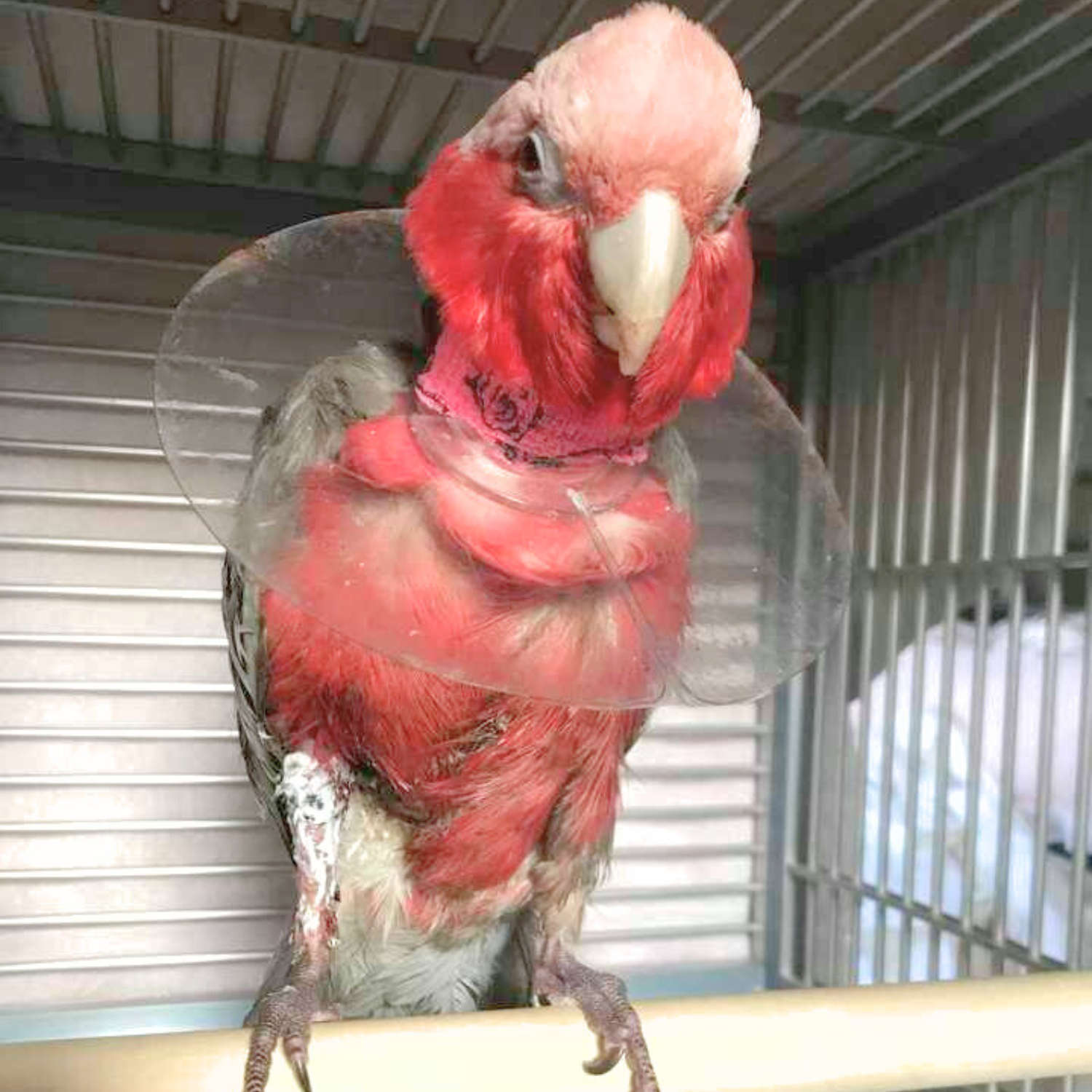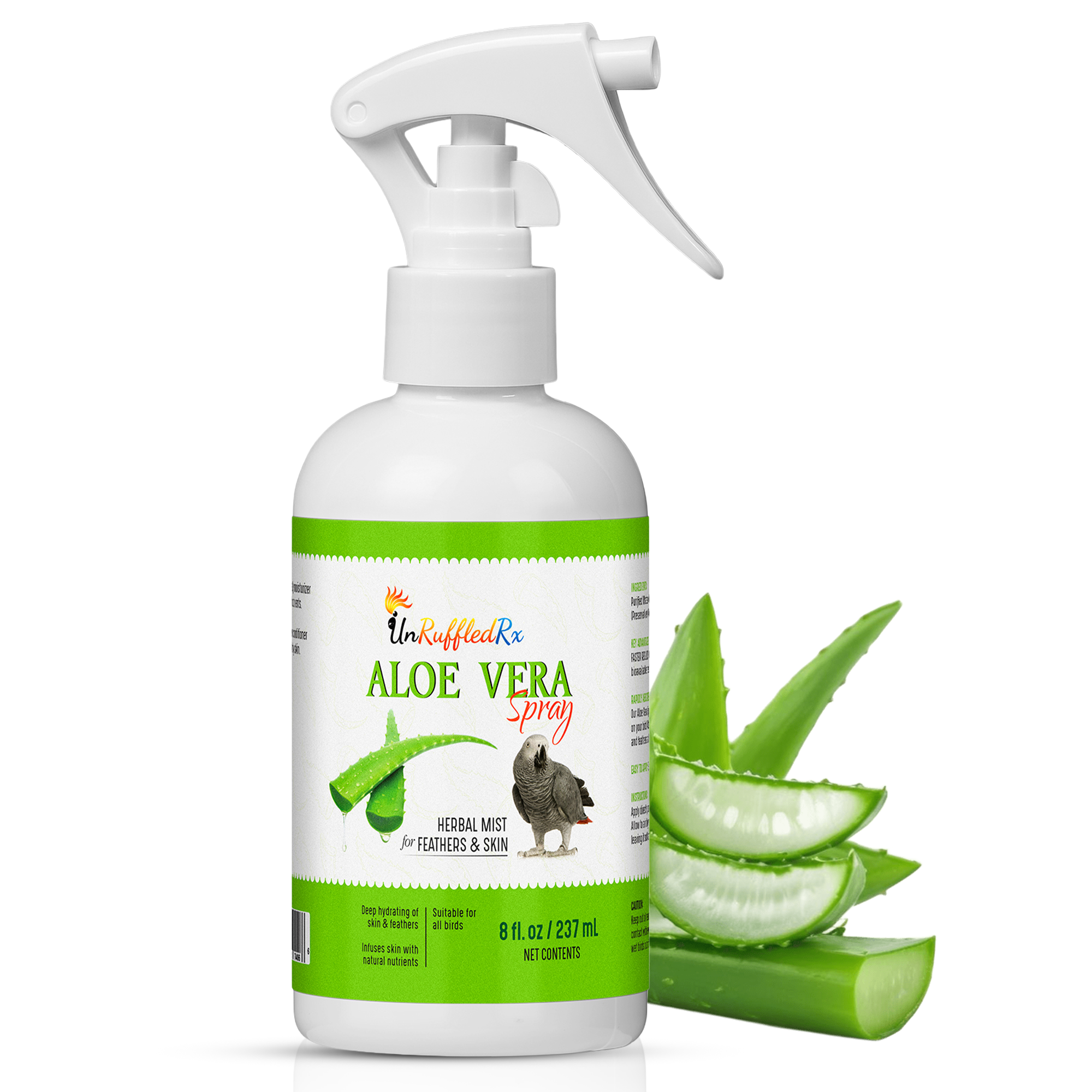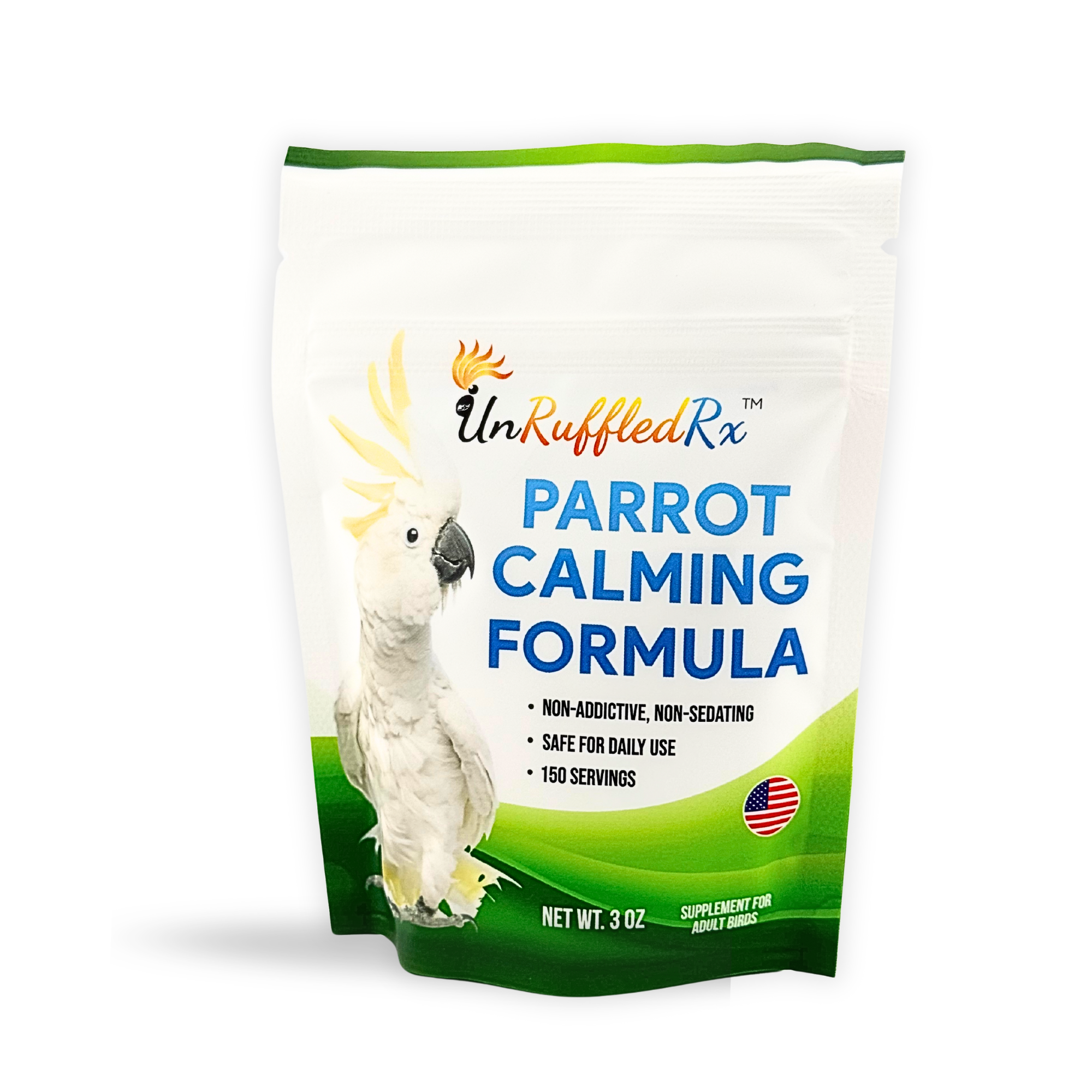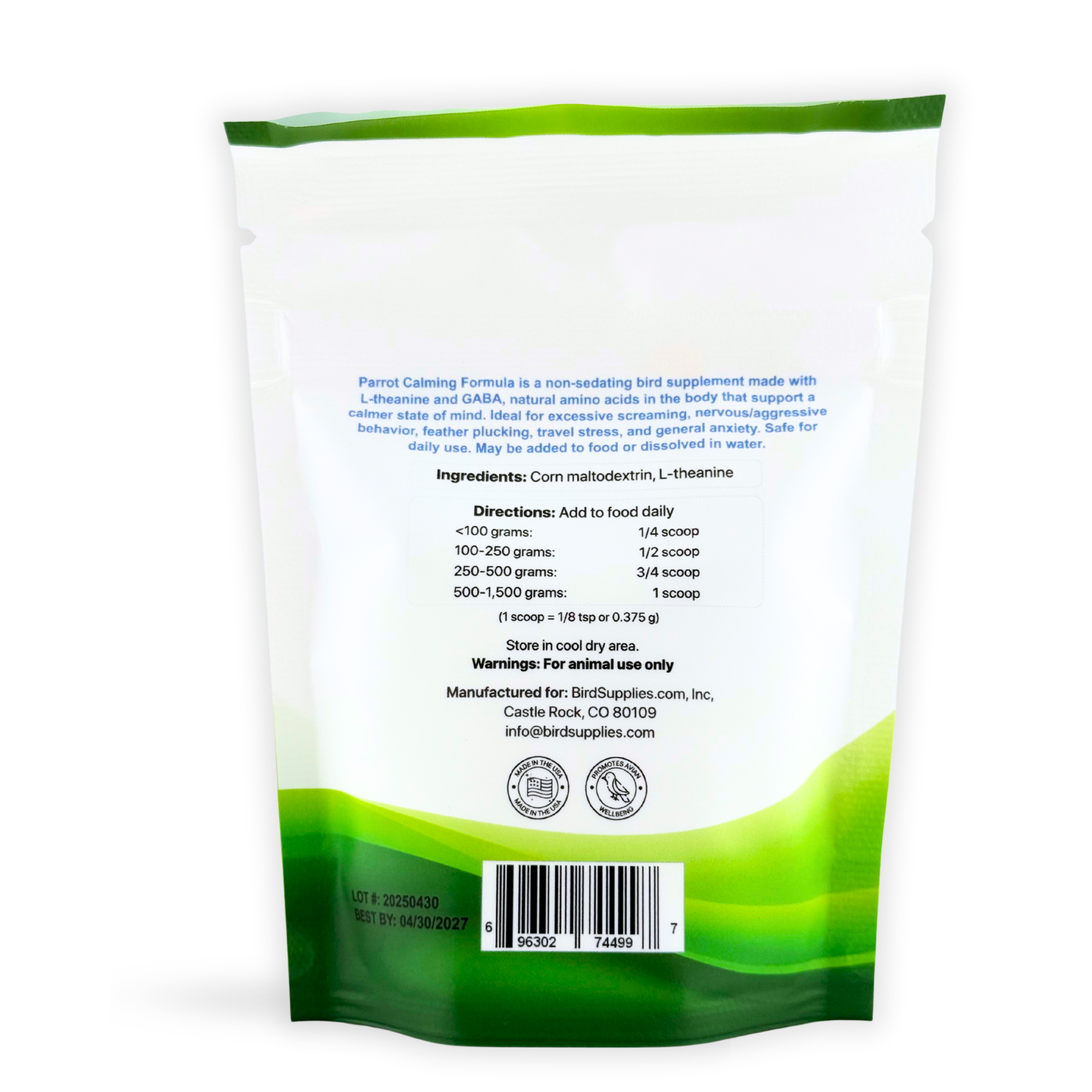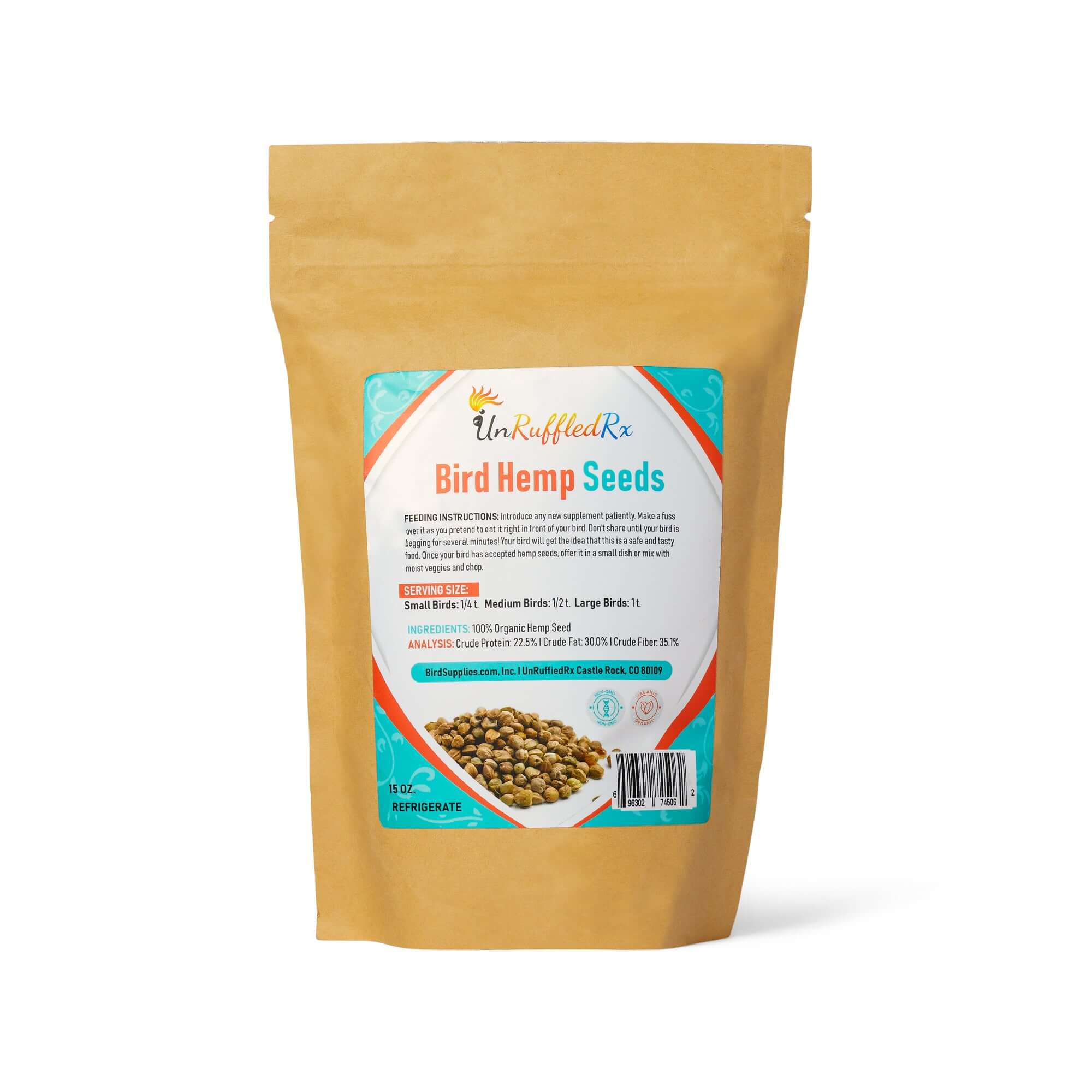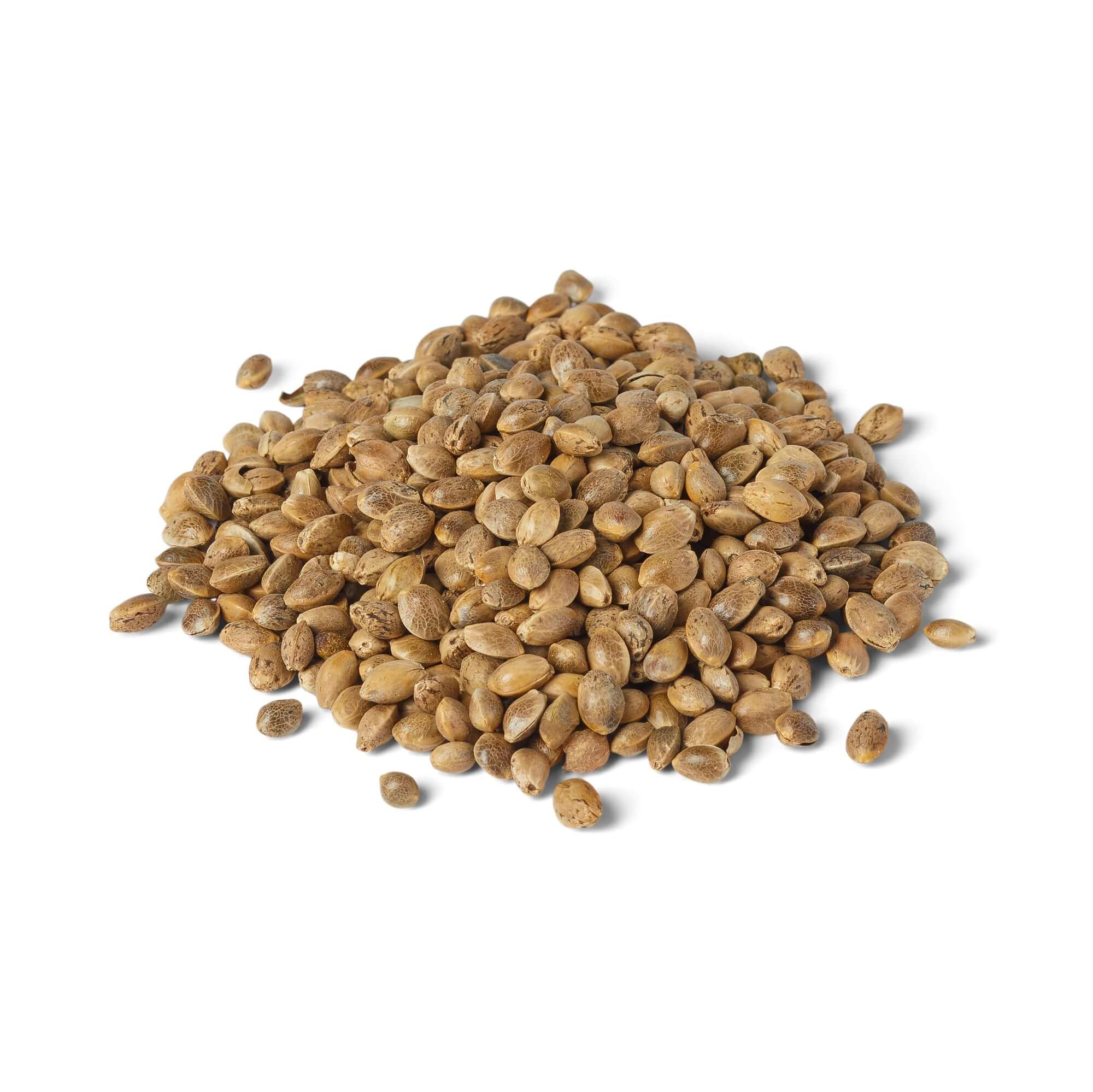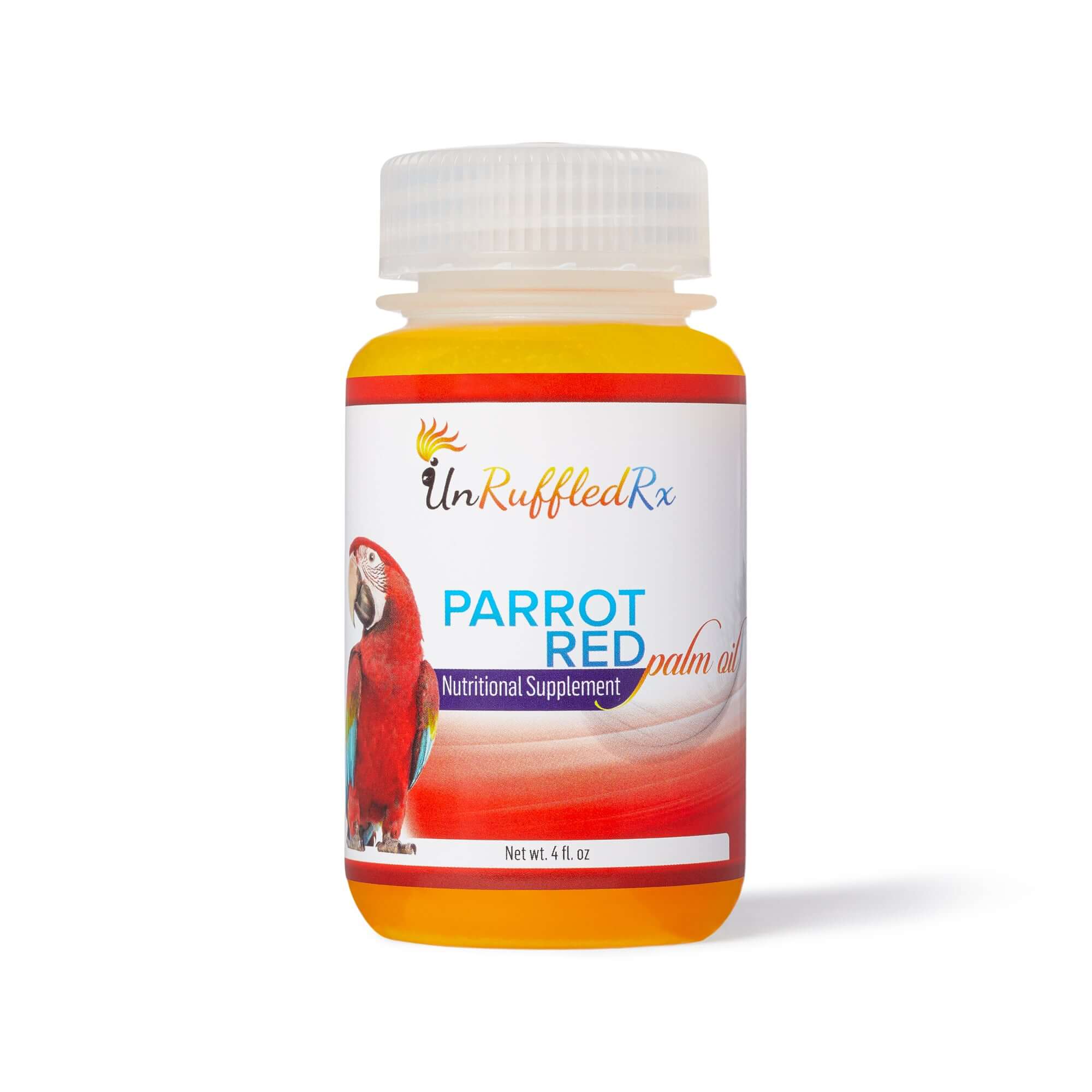Table of Contents
Which Bird Species Self-mutilate?How Can I Stop My Parrot From Mutilating?
Potential Medical Causes For Bird Self Mutilation
Why Does My Bird Keep Biting Himself?
- Preventive Health Care
- Diet and Nutrition
- Behavioral Training
- Enrichment
- Pain Management
- Pediatric & Geriatric Care
- Psychotropic Medications Used For Feather Plucking and Bird Self mutilation
Your bird relies on you to notice the signs and take action to improve their well-being. By understanding the causes and exploring treatment options, you can make a big difference in their life. Read on to learn how to support your bird, reduce their stress, and guide them toward a happier, healthier future.
WHAT IS BIRD SELF MUTILATION?
Self-mutilation in birds is very different from feather-damaging behaviors. Feather-damaging behaviors include over-preening, chewing on the feather shaft, and even pulling feathers out entirely. Self-mutilation, however, takes it a step further—this is when a bird begins to bite or injure its own skin. As you can imagine, this behavior can escalate quickly and may lead to serious, life-threatening situations if not addressed.
As a board-certified psychotherapist and bird behaviorist, I view bird self-mutilation as a sterotypical or compulsive behavior. So what does this mean? Here are the characteristics of compulsive, stereotypical behavior:
-
Repetitively engages in a behavior
-
Repeating the behavior despite harmful consequences
-
A sense that your bird can’t control the behavior
-
Your bird experiences an intense urge or craving to perform the behavior
- Your bird gets a sense of pleasure from the behavior
WHICH SPECIES OF BIRDS SELF MUTILATE?
elf-mutilation in birds, while less common than other feather-related behaviors, is seen more frequently in certain species. Studies have shown that cockatoos and African grey parrots are particularly prone to self-mutilation, with these species often displaying behaviors that start as feather plucking and escalate to damaging their own skin. In fact, one study reported that nearly 40% of African greys and 43% of cockatoos may engage in feather-destructive behaviors, including self-mutilation.
Lovebirds, quaker parrots, and parrotlets also show a higher likelihood of developing these behaviors compared to other species. Research suggests that their unique emotional and social needs, combined with their high intelligence, make them more susceptible to stress and related behaviors. Understanding which species are more predisposed can help bird owners take proactive steps to prevent and address these challenges. (Sources: Vet Times; Journal of Avian Medicine and Surgery, 2016.)
Imagine these species in the wild, where they thrive in large, bustling flocks. These are what we call "flock species," parrots whose survival depends on the constant companionship of their flock mates. Their brains are uniquely wired to rely on their flock for both physical safety and emotional well-being, making social interaction a vital part of their lives
Biologists say that these birds develop strong bonds with each other, engage in elaborate feeding habits, and even possess their own distinct dialects. They literally depend on each other for day-to-day survival.
One possible reason pet birds may start self-mutilating is the deep isolation they feel when they lack the social support of a flock. For flock species, being alone can trigger intense feelings of anxiety, loneliness, and vulnerability, leaving them in a constant state of stress. This stress might drive a bird to cope by plucking feathers or harming itself. However, it’s important to understand that self-mutilation is far more complex than just isolation—it often involves a combination of emotional, physical, and environmental factors.

Shutterstock Licensed Image
Parrots become compulsive self-mutilators for a number of reasons. Compulsive behavior is a form of anxiety disorder. Anxiety may be due to the bird’s genetic predisposition, factors such as feeding by hand during childhood, or a traumatic event. We often see captive animals develop compulsive disorders, partly because they are not being provided with enough stimulation.
To learn more about this check out 9 Reasons Behind Parrot Self-Mutilation.
Yes, anxiety is a mental state that many vets believe can lead to feather-pulling, self-mutilation, and other repetitive behaviors like constant screaming, foot-tapping, or pacing back and forth.
Research also shows that when a young chick is removed from its nest and separated from its parents to be hand-reared for the pet trade, it becomes highly vulnerable to developing anxiety and aggression as it matures. This early trauma may rewire the bird’s brain, leaving it hyper-anxious and more prone to stress throughout its life.
Wander through the Amazonian rainforest in South America and you’ll find quite a few Amazons and Macaws wandering about in small groups of only two to four birds, which they call nomadic species.
Nomad bird species aren’t nearly as stressed about being left alone. But, they aren’t immune to bird self-mutilation. They still need environmental enrichment and a range of parrot wellness care in order to thrive as a pet.
HOW CAN I STOP MY PARROT FROM MUTILATION?
The first step in addressing bird self-mutilation is often to interrupt the self-harming cycle, and one of the most effective ways to do this is by using durable, well-designed bird collars. These collars are specially made to prevent a bird from reaching and damaging its skin while still allowing them to move comfortably. If you're not sure what type of collar to use, take a look at these two common styles to see which might work best for your bird./p>
The one on the left is for a mild plucker. It’s thinner and more flexible. The one on the right is thicker and more rigid, which makes it harder to get around.

When you combine a compulsive self-mutilation habit with a strong, destructive beak and dexterous feet, it’s no surprise that a bird can pull off a Houdini act and escape from many bird collars.
We've developed 3 bird collars and the BeakGuard Bird Vest to support bird self mutilation. A lot of our customers have reported that they've gotten creative with combining styles for even more protection. That's how we created the Bird Self Mutilation Combo.
Once you’ve interrupted the self-mutilation behavior with a bird collar, it’s time to address the root cause. The underlying issue could be medical, behavioral, or, as is often the case, a combination of both. Understanding and treating these contributing factors is key to breaking the cycle and helping your bird heal.
Let's take a look at the common medical and behavioral issues that contribute to parrot self-mutilation and other compulsive behavior in our pets.
POTENTIAL MEDICAL CAUSES OF BIRD SELF MUTILATION
So as previously stated, the root causes of parrot self-mutilation fall roughly into two categories: medical and non-medical (or behavioral).
Your bird veterinarian may perform a series of tests to help determine whether there is a medical reason for the self-mutilation.
WHY DOES MY BIRD KEEP BITING HIMSELF?
Research is increasingly revealing that self-mutilation in birds closely aligns with human psychiatric conditions. Consider Trichotillomania, a self-harming disorder where individuals feel compelled to pull out their own hair, or those who engage in cutting as a way to cope with emotional distress. Despite the physical pain or social consequences, people with these conditions often find the behavior impossible to resist, underscoring the deeply compulsive nature of self-harm.
This is why they're called OCD. Experts used to think that self-harm urges occur because the brain’s chemical signals (called neurotransmitters) aren’t working properly. Now, we know that the amygdala in these people’s brains is hyper-reactive.
The Amygdala is part of the limbic system. We think it plays a huge role in emotion and behavior. It’s best known for its role processing fear, but we’re learning that it plays a huge role in other emotions, too.

Infographic Developed by Diane Burroughs, LCSW
WHAT IS PARROT WELLNESS
When it comes to feather plucking, non-medical causes often stem from factors that create physical or emotional stress for our exotic pets. These stressors can typically be grouped into three main categories, all falling under the broader concept of “Parrot Wellness.” By addressing these areas, we can work toward creating a healthier, happier environment for our feathered companion
These include:
- Environmental issues
- Parrot husbandry issues
- Behavioral issues.
When a parrot’s environmental, social, and physical needs aren’t met, stress levels can rise dramatically. This stress triggers the release of adrenaline, which can fuel self-mutilation behaviors and make it even harder for your bird to calm down.
If you’re facing the challenge of a self-mutilating bird, it’s natural to seek information and support online. While support groups can provide comfort and a sense of community, they often reflect individual experiences rather than insights based on scientific studies or professional expertise. What works for one bird may not work for another.
Support groups can be a valuable resource for sharing ideas and feeling less alone, but they are not a substitute for professional guidance. For the best chance of helping your bird, it’s essential to work with a trained and certified bird behaviorist. These experts can assess your bird’s unique needs and provide a tailored approach to reduce stress and support their well-being.

Many people assume that parrot wellness is only about diet and nutrition. While these are important, true parrot wellness goes much deeper. To effectively address self-mutilation, it’s essential to incorporate all six elements of parrot wellness into your bird care routine. Each element plays a vital role in supporting your parrot’s physical, emotional, and social well-being.
Every day, I receive phone calls and emails from concerned bird lovers asking how to stop bird self-mutilation. Many try one solution or another, only to feel discouraged when it doesn’t work. That’s because self-mutilation is a complex issue, and a single approach often isn’t enough to resolve it.
If you truly want to help your parrot heal, it’s important to take a comprehensive approach. Incorporating a "full-blown system" like the one outlined above can address the root causes of self-mutilation and provide your bird with the support they need to recover. Taking action on all aspects of their wellness—not just one—can make a world of difference for both you and your feathered friend.
Providing for your bird’s overall well-being is one of the most effective ways to address challenging behaviors. This approach doesn’t just focus on stopping the behavior—it supports your bird’s health and happiness, creating the best possible environment for them to thrive. Whether or not the behavior resolves immediately, maintaining your bird’s wellness is always worth the effort.
Parrot wellness is especially important when caring for exotic pets like parrots. Think about how you feel when you’re physically healthy and free from stress—it’s when you’re at your best! The same is true for your feathered friend.
Researchers at the Richard M. Shubot Parrot Wellness Program at UC Davis have developed a systematic, science-based approach to parrot care. They’ve identified six essential elements critical to supporting a bird’s physical and emotional well-being. By following these principles, you can help your parrot feel their best and build a stronger bond with them.
-
Preventative Health Care
-
Diet & Nutrition
-
Behavioral Training
-
Environmental Enrichment
-
Pediatric & Geriatric Care
- Pain Prevention and Management
Preventive Health Care
When you own an exotic pet, prevention is key to keeping them healthy and happy. Birds instinctively hide signs of illness, injury, and even emotional pain as a survival mechanism, making it challenging to recognize when something is wrong. Routine wellness exams are one of the most effective ways to catch potential problems early, when they’re easier to treat and manage.
A bird that isn’t feeling well often stops eating, which can quickly lead to serious health issues. With their high metabolism and unique bodies adapted for flight, birds can decline rapidly without proper nutrition. By the time noticeable symptoms appear, it’s often too late to intervene effectively.
To help ensure your bird’s long-term health, here are three actionable steps to take:
- Schedule Annual Wellness Exams: Regular checkups with an avian vet can detect subtle signs of illness or imbalance before they become serious. Early detection can save your bird’s life.
- Monitor Eating and Self-Care Habits: Keep an eye on your bird’s appetite and grooming routines. Any changes, like decreased eating or neglecting their feathers, should be addressed immediately with your vet.
- Follow Your Vet’s Advice: Your avian veterinarian is trained to spot and address potential issues. Stick to their recommendations for diet, environment, and preventive care to keep your bird thriving.
Proactive care makes all the difference. By focusing on prevention and working closely with your vet, you can give your bird the best chance at a long and healthy life.
Diet and Nutrition
Some parrots resort to biting themselves out of discomfort, whether it’s mental or physical. One major contributor to these behaviors is inadequate nutrition, which can leave birds malnourished and struggling to cope. Proper, balanced nutrition is essential for maintaining both physical and mental health in parrots.

To support your bird’s health, we recommend feeding them high-quality pellets alongside a diverse range of raw, plant-based vegetables, fruits, herbs, grains, and essential oils. A nutrient-rich diet can help address many underlying issues that contribute to self-destructive behaviors.
Interestingly, human studies on anxiety disorders offer valuable insights. Research shows that improving diet, increasing exercise, and ensuring proper sleep can significantly reduce anxiety levels. These same factors—nutrition, physical activity, and rest—are just as important for parrots and are considered essential components of their care.
For a deeper dive into how malnutrition affects your bird and practical steps to improve their diet, check out our article: Signs of Bird Malnutrition and How to Fix Your Bird’s Diet.
 Appropriate diet, exercise, and sleep should be at the top of your “must-do list” parrot care routines.
Appropriate diet, exercise, and sleep should be at the top of your “must-do list” parrot care routines.
Thinking about changing your self mutilating bird's diet? Join the conversation on Facebook! Join the Avian Raw Whole Food Nutrition to learn how to improve your bird's physical and mental health.
Karmen Budai, a key expert in this field, has authored a couple of incredibly insightful books to help you improve your bird’s diet. These books are filled with wholesome bird recipes that you can easily create using ingredients from your local grocery store. You can explore and purchase them right here.
Now, let' look at the importance of activity and exercise.
Investing in a quality bird stand is one of the best decisions you can make for your bird’s health and well-being. A sturdy stand, like a Java Tree, may seem like a significant upfront cost, but it’s an essential piece of equipment that encourages movement and provides priceless preventative health benefits. A sedentary bird with little opportunity for exercise can face serious health issues, potentially leading to costly vet bills. Why not give your bird what it truly needs—daily exercise and a space to stay active and engaged—for a lifetime of better health?
One more way to help your bird feel his best is to make sure he’s getting the 10-12 hours of sleep that he needs every night. This is why you should consider getting your bird a sleep cage.
Hint: Travel bird cages can double as a bird’s sleep cage and a hospital bird cage.
The Perch and Go Bird Carrier by Featherland is a great travel, sleep, or hospital cage. This handy cage is ideal for small to medium birds.
Bird Behavior Training
Parrots are widely known as some of the most intelligent animals on the planet. They are also incredibly social creatures, thriving in the wild within complex social structures where isolation is virtually nonexistent. In fact, parrot parents often spend years teaching their young the skills they need to survive and thrive within their flock.
Life for domesticated birds is vastly different from that of their wild counterparts. As you might imagine, their upbringing is also drastically altered. Sadly, many bird breeders separate baby parrots from their parents to hand-feed them, denying these young birds the opportunity to learn natural parrot behaviors.
Many parrot owners don’t realize the importance of teaching their birds natural parrot behaviors, or they simply don’t know where to start. Skills like eating a variety of healthy foods, bathing, grooming, and foraging for food are essential for a bird’s physical and mental health. As a parrot owner, it’s your opportunity—and responsibility—to guide your bird in developing these natural instincts to help them thrive in their domestic environment. Why not start today?

These are all essential, inborn skills that your bird needs to thrive as a parrot. Teaching your bird these natural behaviors doesn’t have to be complicated—it’s actually a fun and rewarding experience. With their intelligence and social nature, parrots are eager learners, and training is a wonderful way to strengthen your bond.
A fantastic resource to get started is the book Clicker Training for Birds. This affordable and time-tested guide is packed with clear, easy-to-follow instructions that use positive, science-backed methods to train your bird. You’ll be amazed at how quickly your feathered friend picks up new skills.
By combining improved bird care with thoughtful training, you’ll start to see noticeable improvements in your bird’s behavior. Imagine the stress relief and happiness your bird will experience as they gain confidence and learn to thrive in their environment.
Bird Enrichment
Birds are incredibly intelligent and highly social animals, with brains wired for constant engagement and exploration. In the wild, they encounter endless enrichment opportunities, from sensory stimulation in their vibrant environments to problem-solving while foraging and manipulating objects. While it’s impossible to fully replicate these experiences in captivity, we can still provide our birds with meaningful enrichment at home.
Enrichment involves activities and tools that stimulate your bird’s senses, challenge their problem-solving abilities, and encourage natural behaviors like foraging, chewing, and climbing. By offering safe objects to manipulate, puzzles to solve, and opportunities for exploration, you’re helping your bird stay mentally and physically healthy while reducing stress and boredom.
One of the most valuable skills we can teach our birds is foraging. Foraging encourages your bird to use its natural problem-solving abilities to work for a portion of its diet, just like they would in the wild. I teach you all about how to incorporate foraging into your bird’s daily routine in my book, providing simple, actionable steps to help your feathered friend thrive.
book and this video.Did you know that birds have better hearing than dogs? Or that their vision is among the best in the animal kingdom? Providing them with sensory stimulation is essential to support their natural instincts and overall well-being.
Incorporate activities and items throughout the day that engage your bird’s senses. A bird that stays mentally and physically stimulated is far less likely to develop destructive habits like chewing on itself.
Here are several ways to meet your bird's sensory needs:
- Create foraging opportunities for your pet so that it has to figure out how to get their nutrition.
- Provide your bird with a rich and varied plant-based diet.
- Offer your bird auditory stimulation in the form of music or talk shows. If you have a bird with separation anxiety make an audio or video recording of yourself that you can play for your bird when you're away.
- One of my favorite resources is Bird TV For Parrots on YouTube
- Offer your bird visual stimulation with a variety of colorful toys and a treasure chest of things to forage through.
Pain Management
I've already established how birds are innately wired to hide pain in illness. But, that doesn’t mean that they have no pain.
If your bird is one of those who doesn't eat healthy foods and doesn't get enough exercise, it will eventually end up stiff and sore.
You might be surprised to learn that a bird who self-harms may have fallen into a vicious cycle creating physical pain to compensate for its emotional pain.

Try to determine if your bird might be in pain and talk with your vet about it. There are a few avian safe pain medications that your vet can prescribe for you. Take this Bird Pain Assessment to help you understand if this is part of the problem.
Bird-specific CBD oil or bird-specific hemp seed are alternative supplements that can support birds in pain from mild to moderate.
Both Hemp Seed and CBD Oil support pain, inflammation, cardiovascular health, and so much more. It only takes a little bit for your birds to feel some relief.
Some people have a concern that they're giving their birds something that could cause them to get high, but neither is Hemp Seed or Bird High. CBD Oil contains THC.
Pediatric & Geriatric Care
A lot like a young child or puppy, your bird has different care needs at different stages of life. This is another reason to maintain a regular relationship with your avian vet. Avian vets and veterinary techs can be a valuable resource for coaching you on meeting your parrot’s needs during the various life stages.
HOW A BIRD BEHAVIORIST HELPS WITH BIRD SELF-MUTILATION
We now know that Applied Behavior Analysis is the second most effective approach to stopping bird self-mutilation, after ensuring their complete well-being.
Self-mutilating parrot behavior can quickly get out of hand, so it makes sense to address the issue while consulting a with a bird behaviorist in addition to working with your avian vet.
When you’re working on a potentially life-threatening issue like bird self-mutilation, you need to plan on multiple sessions. I routinely see my clients on multiple occasions. Why? Because behavioral change is science. It’s a process, and it takes time to unravel.
Most people really don’t realize the difference between a bird trainer and a bird behaviorist.
Imagine it as deciding between taking your new pup to puppy kindergarten for some basic socialization vs. hiring a highly-trained specialist who can accurately assess and correct complicated, challenging behavior.
These professionals had a rigorous training in applied behavioral analysis (ABA), and the vast majority of truly great bird behaviorists hold a master’s degree or a doctorate in one of the behavioral sciences.
Don't be afraid to ask the bird behaviorist what their credentials and background are. A good bird behaviorist will tell you about their training.
Don’t be afraid to ask for ‘package deals.’ In other words, pitch in for a discount on follow-up appointments. Some practitioners offer bundle pricing while others urge you to sign up for a year-long package.
A dangerous problem like bird self-mutilation is ultimately about saving your bird’s life.
Psychotropic Medications Used For Feather Plucking and Bird Self mutilation
Sadly, a compulsive mutilation habit that has gone on for a few years may have become so ingrained that it requires psychotropic medications.
The good news is that they tend to work quickly once you and your vet have determined which particular drug the bird tolerates and the right dosage to quiet its behavior, but not make it seem like it is drugged up.
Well...quite literally. Avian Veterinarian Dr. Jeffrey Jenkins claims a 90% success rate in treating difficult to manage birds who self-harm. That's amazing! And your bird might be a successful candidate too. You can see Dr. Jenkins on this video
Cockatude 14.
Some birds’ vets have reservations about prescribing psychotropic drugs as an aid in feather-pulling and self-mutilation in birds. Birds don't tolerate many medications in the same way that mammals do. In addition, research into what bird medicines they tolerate is fairly sparse.
Just like your physician, veterinarians have to abide by the concept of “do way more good than harm.”
The Merck Veterinary Manual is the Hallmark resource on which psychotropic medications have been researched for birds.
They identify 5 psychotropic medications for feather plucking (and bird self mutilation)
- Amitriptyline
- Clomipramine
- Diazepam
- Haloperidol
- Fluoxetine
For more information on bird medications, please read this article, The Do's and Dont's of Calming a Stressed Bird
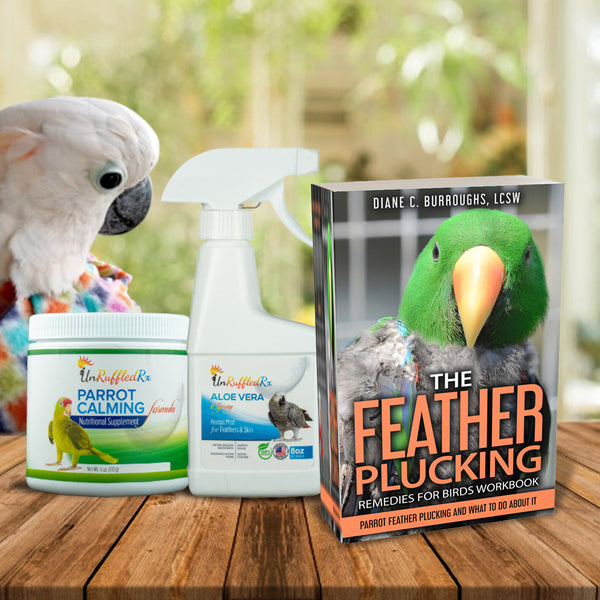
Disclaimer Alert. I'm not an avian vet. I'm a clinical psychotherapist with considerable psychiatric hospital experience and a bird behaviorist that specializes in feather plucking birds and bird self mutilation.
In Conclusion,
So, now you've learned about bird self-mutilation treatment options. Bird self-mutilation is not a simple problem like screaming or biting. Your beloved pet could die over this. Develop a partnership with your avian vet and with a bird behaviorist for optimum results.
Related Posts:
The Do's and Don'ts Of Calming a Stressed Bird
10 Ways To Curb Bird Self Mutilation Without Breaking The Bank
Understanding Parrot Stress and What To Do About It
References:
Clubb, S., & Seibels, R. (2018). Avian psychological health and behavioral enrichment. Proceedings from the Association of Avian Veterinarians Annual Conference. Retrieved from https://www.aav.org
Harrison, G. J., & Lightfoot, T. L. (2006). Clinical avian medicine (Vol. 1). Palm Beach, FL: Spix Publishing.
Jenkins, J. R., & Johnson, J. (2015). Avian behavioral studies: Insights into chronic stress and self-mutilation in companion birds. Journal of Exotic Pet Medicine, 24(3), 213–220. https://doi.org/10.xxxx
Ritchie, B. W. (2020). Advances in avian dermatology: Causes and treatments for feather and skin disorders. Avian Veterinary Medicine Journal, 33(2), 154–169.
Speer, B. L. (2016). Hormonal influences on self-mutilation in parrots: Causes and management strategies. Journal of Avian Health and Behavior, 22(4), 89–96.
Teflon and environmental toxins: Preventing avian health risks. (2020). Avian Veterinary Care Recommendations. Retrieved from http://www.avianvets.org
Understanding nutritional deficiencies in avian care. (2018). Avian Medicine and Surgery Journal, 27(1), 45–58.
Promises Behavioral Health. (n.d.). Compulsive self-mutilation. Retrieved from https://www.promisesbehavioralhealth.com/addiction-recovery-blog/compulsive-self-mutilation/
Zencare. (n.d.). Compulsive behaviors. Retrieved from https://zencare.co/mental-health/compulsive-behaviors
Youtube. (n.d.). Cockatude 14. Retrieved from https://www.youtube.com/watch?v=TfOCjf6YgV8
Diane Burroughs, LCSW is a licensed psychotherapist trained in ABA therapy techniques. She specializes in avian anxiety disorders and is certified in Nutrition For Mental Health. Diane has written a number of bird behavior books and she offers behavior consultations. She's developed a range of UnRuffledRx Science-backed Parrot Wellness Supplies.
Diane's products have been featured in the Journal of Avian Medicine and Surgery and at Exoticscon, a conference for exotic pet veterinarians. Her bird collars & supplements are stocked in avian vet clinics and bird stores throughout the US. With over 30 years in the field of behavior, Diane has created thousands of successful individualized behavior plans that help pets thrive.
TAGS: #ParrotSelfMutilation #BirdSelfMutilation
SHARING IS CARING! PLEASE SHARE ON YOUR FAVORITE SOCIAL MEDIA NOW!

